Ohakune in the summer is fairly quiet; it’s more a winter destination. But Mountain Bike Station was doing a steady trade when we picked up our hire bikes, e-bike and mountain bike with knobbly tyres and panniers, for our five-day adventure on the Mountains to Sea Cycle Trail from Tūroa to Whanganui.
Just past the i-SITE, which had a huge amount of information on the outdoors and attractions specific to Taranaki, the Tongariro/Mount Ruapehu area, Mountains to Sea Cycle Trail and Whanganui River, there are easy walking trails in the Jubilee Park Scenic Reserve. We walked through lush bush dappled by end-of-day light, along a stream, then came across a wooden bridge leading to Ohakune Top10 Holiday Park.
The camping ground had a number of motorhomes parked up, and lots of cabins. Two minutes’ walk back to town and things had livened up, with people enjoying the warm evening at tables and chairs on the pavement outside ‘The Mountain Rocks’, a café, restaurant and bar. Easily seen at the end of side streets, distant Mount Ruapehu still had streaks of snow in its upper valleys, its peak covered by cloud.
We passed colonial-era houses on the town’s outskirts on our 19 kilometre drive to Tūroa ski-field – more a rock field in January – to see the sunset. It was sweltering in Ohakune, but bleak, chilly and deserted at Tūroa. Cloud cover was too low for a view. On our way down, the sunset blazed orange behind trees, as if on fire.
We detoured to Ohakune Railway Station. The closed-up, 1908 yellow wooden building made striking with deep-red window frames has Historic Place Category 2 status.
Steph from Mountain Bike Station dropped us at the Old Coach Road trailhead. Less than 100 metres away, thousands of rusting cars, tractors and trucks from the 1920s to 1970s, perhaps beyond, cluttered acres of dry brown fields. Vauxhalls, Valiants, Cortinas… doors hung open, bonnets up, some balanced on another. Mainly rust-red, a few newer models gave a splash of colour.
Horopito Motors, pretty much the only thing in Horopito, is a car enthusiast’s dream. For $10 you can wander among them. The few wooden buildings, used to store parts, looked like something from an early 1900s movie set. The business, better known as ‘Smash Palace’, appeared in New Zealand movies Smash Palace and Goodbye Pork Pie in the 1980s.
The trail is graded intermediate. Not being regular bike riders, we still found it relatively easy. On the shaded trail that traversed Tongariro National Park’s edges, we rode over setts (handmade cobbles) which had our tyres skidding at times. Rātā trees choked rimu trees, a stand of lush, tropical-looking mountain cabbage trees grow near concrete piers being swallowed by grass and bush, the remains of Haeremaere Bridge.
Boards told of engineering feats, coach journeys when windows iced up and icicles hung from the ceiling, of building the railway line with nothing more than picks, shovels and wheelbarrows, and workers’ harsh lives living in tents in the coldest, wettest place in the North Island.
Riding through dense bush, our peacefulness was disturbed by an intensifying roar. I expected something to hurtle at us but the sound diminished then died away. Not long after, we rounded a corner to find the Hapuawhenua Viaducts, long lines cutting across a never-ending green backdrop which they disappeared into. The only cyclists we’d seen told us the Northern Explorer enroute to Wellington had just sped over the new viaduct.
Cycling the old one, which in 1904 was the longest, curved overpass in the Southern Hemisphere and has Category 1 Historic Places Trust status, was slightly scary when looking over the rails at a carpet of shaggy greenery far below. I found it incredible as to how, faced with such a steep, deep valley, workers managed to construct the 43 metre-high bridge. Sounding like a helicopter, an engine appeared pulling red and yellow goods wagons across the new viaduct southbound.
In the past trains have powered through the dark Hapuawhenua Tunnel. We rode it, a pinprick of light at its far end. I thought we might spot glow-worms, but there was nothing but a locked gate at the end looking out onto bush.
Shortly afterwards there were forever views over rolling farmland. Leaving Old Coach Road, we cycled the scenic trail along Mangawhero River, flat farmland on the opposite side.
Almost four hours after starting the trail we arrived back in Ohakune. Time to laze before the following day’s leg along Middle and Ruatiti Roads. From Ohakune, it’s a ride of 57km... but we were cheating; again. We had a shuttle booked to take us to the junction of State Highway 4 and Middle Road, which knocks off nearly 14km of cycling. After all, we were on holiday!
• Mountains to Sea Cycle Trail information: mountainstosea.nz
• Ohakune Top10 Holiday Park is handy to bike rentals, i-SITE and a supermarket.
• DOC’s Mangawhero Campsite is 5km from Ohakune and is suitable for motorhomes.
• On the banks of the Manganuioteao River, 17.4 from Ohakune, Ruatiti Domain has freedom camping. The river can be swum and trout fished. The Horopito to Mangapurua Trail leg of the Mountains to Sea Cycle Trail (43km) runs past on a mixture of gravel and tar seal, mostly flat or downhill. Pre-book a shuttle back to Ohakune, or get non-cyclists to drive the motorhome to Ruatiti Domain. Find out more.
• Pipiriki, 38km from Ohakune, is the start of the Whanganui River Road section of the Mountains to Sea Cycle Trail. Pipiriki Camping Ground is run by Whanganui River Adventures, who operate jet boats along Whanganui River, visiting the Bridge to Nowhere.
• Whanganui River Road undulates, following the river. Freedom camping is available at DOC’s Otumaire, 39km from Pipīrīki. 48km away, Rivertime Lodge accepts caravans and motorhomes.
Find motorhomes, caravans and RVs for sale in NZ
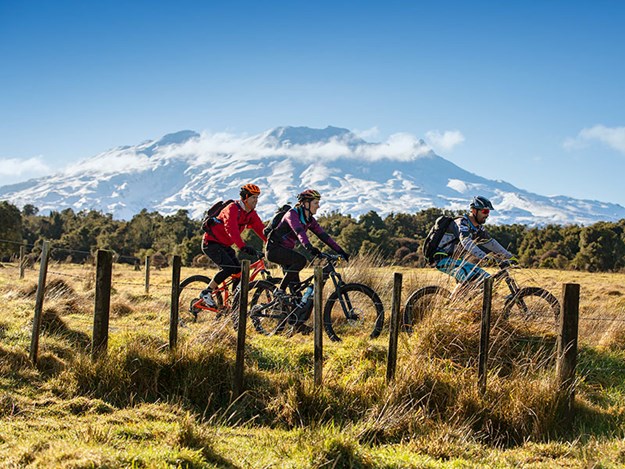 |
|
Biking the Ohakune Old Coach Road |
Discovering Ohakune
With bikes sorted for the following day, we wandered the main street. A number of places were shut for the season including, disappointingly, ‘The (famous) Chocolate Éclair Shop’. The ‘Big Carrot’ marking the town entrance recognises Ohakune’s market gardening history, established in 1925.Just past the i-SITE, which had a huge amount of information on the outdoors and attractions specific to Taranaki, the Tongariro/Mount Ruapehu area, Mountains to Sea Cycle Trail and Whanganui River, there are easy walking trails in the Jubilee Park Scenic Reserve. We walked through lush bush dappled by end-of-day light, along a stream, then came across a wooden bridge leading to Ohakune Top10 Holiday Park.
The camping ground had a number of motorhomes parked up, and lots of cabins. Two minutes’ walk back to town and things had livened up, with people enjoying the warm evening at tables and chairs on the pavement outside ‘The Mountain Rocks’, a café, restaurant and bar. Easily seen at the end of side streets, distant Mount Ruapehu still had streaks of snow in its upper valleys, its peak covered by cloud.
We passed colonial-era houses on the town’s outskirts on our 19 kilometre drive to Tūroa ski-field – more a rock field in January – to see the sunset. It was sweltering in Ohakune, but bleak, chilly and deserted at Tūroa. Cloud cover was too low for a view. On our way down, the sunset blazed orange behind trees, as if on fire.
We detoured to Ohakune Railway Station. The closed-up, 1908 yellow wooden building made striking with deep-red window frames has Historic Place Category 2 status.
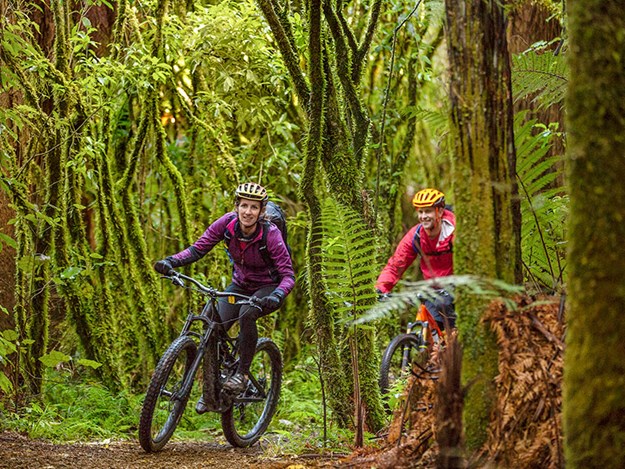 |
|
Lush forest has taken over what was once a coach road |
A surpise at Horopito
We didn’t begin the Mountains to Sea Cycle Trail at its Tūroa start point. We cheated and took a shuttle to Horopito, cycling back to Ohakune. It’s downhill that way.Steph from Mountain Bike Station dropped us at the Old Coach Road trailhead. Less than 100 metres away, thousands of rusting cars, tractors and trucks from the 1920s to 1970s, perhaps beyond, cluttered acres of dry brown fields. Vauxhalls, Valiants, Cortinas… doors hung open, bonnets up, some balanced on another. Mainly rust-red, a few newer models gave a splash of colour.
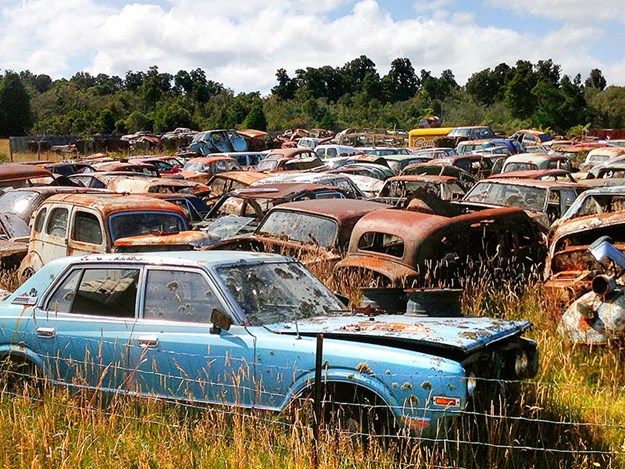 |
|
A vehicle graveyard at Horopito |
On the old coach road
Back at the trailhead, an information board informed us the trail follows two stories; of coach travel, and rail. In 1906, the rail line from Auckland stopped at Raurimu, and from Wellington at Ohakune. A coach road was built between the two while engineers planned how to join the lines, which would involve constructing three major viaducts. By 1909 the job was completed and the forest took over the now barely used coach road. Reclamation of 15km of the road began in 2001.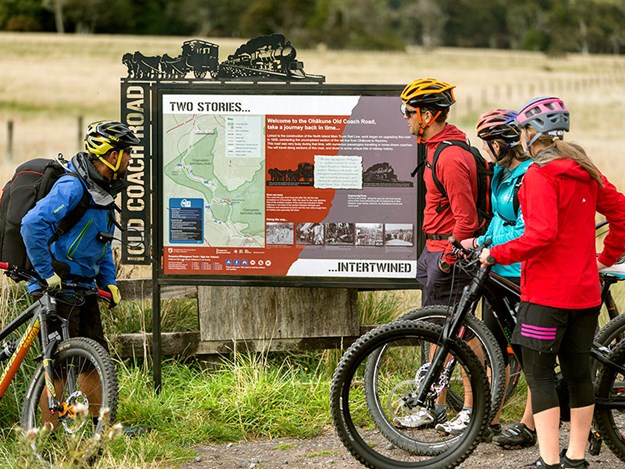 |
|
Checking out the twin histories of the Old Coach Road at the start of the trail |
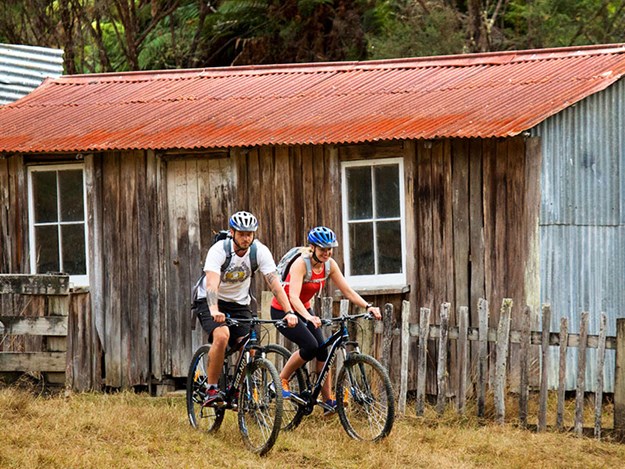 |
|
The trail is graded intermediate, and a relatively easy ride |
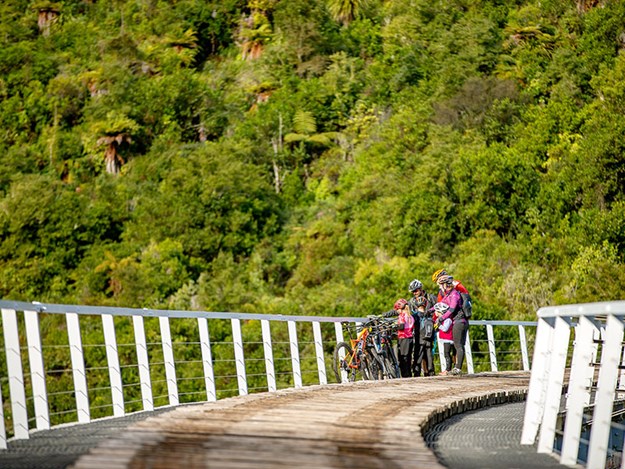 |
|
The trail is graded intermediate, and a relatively easy ride |
Viaducts and trains
Unused since 1987 when the line was straightened, the rust red Taonui Viaduct stretched and curved high above a green canopy. This man-made intrusion could be a blot on the landscape, but instead I found it stunning. The three towers supporting it, as the information board suggested, look like giant, early 1900s Meccano pieces.Riding through dense bush, our peacefulness was disturbed by an intensifying roar. I expected something to hurtle at us but the sound diminished then died away. Not long after, we rounded a corner to find the Hapuawhenua Viaducts, long lines cutting across a never-ending green backdrop which they disappeared into. The only cyclists we’d seen told us the Northern Explorer enroute to Wellington had just sped over the new viaduct.
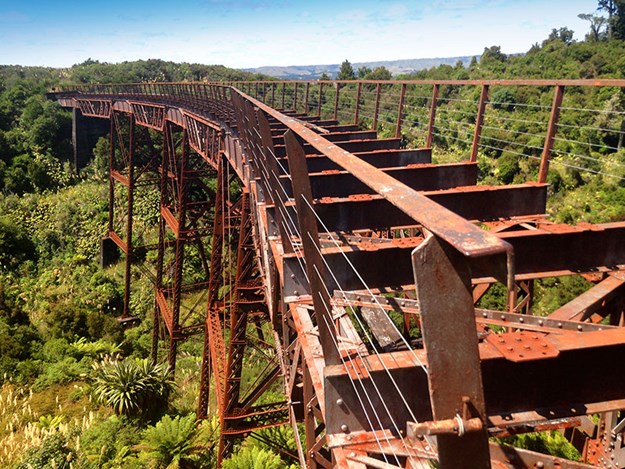 |
|
Taking in the view from the new Hapuawhenua Viaduct; the mighty overpass has been converted into a cycleway |
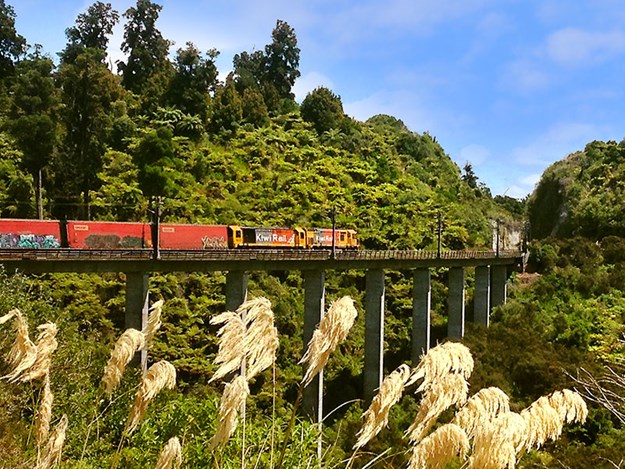 |
|
The old Hapuawhenua Viaduct is a rusty but strangely beautiful relic |
Shortly afterwards there were forever views over rolling farmland. Leaving Old Coach Road, we cycled the scenic trail along Mangawhero River, flat farmland on the opposite side.
Almost four hours after starting the trail we arrived back in Ohakune. Time to laze before the following day’s leg along Middle and Ruatiti Roads. From Ohakune, it’s a ride of 57km... but we were cheating; again. We had a shuttle booked to take us to the junction of State Highway 4 and Middle Road, which knocks off nearly 14km of cycling. After all, we were on holiday!
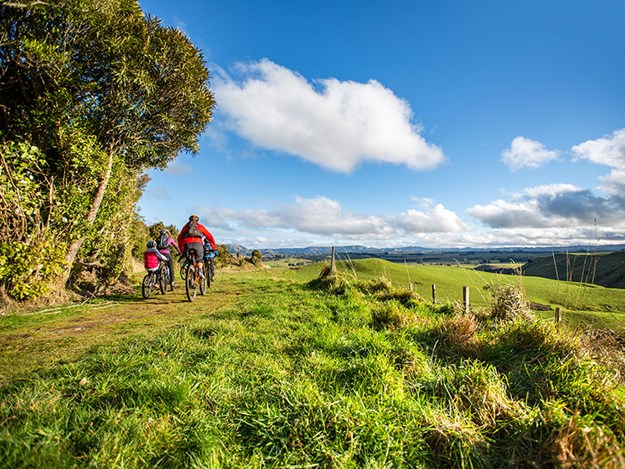 |
|
The old Hapuawhenua Viaduct is a rusty but strangely beautiful relic |
More information
• Mountains to Sea Cycle Trail information: mountainstosea.nz
• Ohakune Top10 Holiday Park is handy to bike rentals, i-SITE and a supermarket.
• DOC’s Mangawhero Campsite is 5km from Ohakune and is suitable for motorhomes.
• On the banks of the Manganuioteao River, 17.4 from Ohakune, Ruatiti Domain has freedom camping. The river can be swum and trout fished. The Horopito to Mangapurua Trail leg of the Mountains to Sea Cycle Trail (43km) runs past on a mixture of gravel and tar seal, mostly flat or downhill. Pre-book a shuttle back to Ohakune, or get non-cyclists to drive the motorhome to Ruatiti Domain. Find out more.
• Pipiriki, 38km from Ohakune, is the start of the Whanganui River Road section of the Mountains to Sea Cycle Trail. Pipiriki Camping Ground is run by Whanganui River Adventures, who operate jet boats along Whanganui River, visiting the Bridge to Nowhere.
• Whanganui River Road undulates, following the river. Freedom camping is available at DOC’s Otumaire, 39km from Pipīrīki. 48km away, Rivertime Lodge accepts caravans and motorhomes.
Find motorhomes, caravans and RVs for sale in NZ





